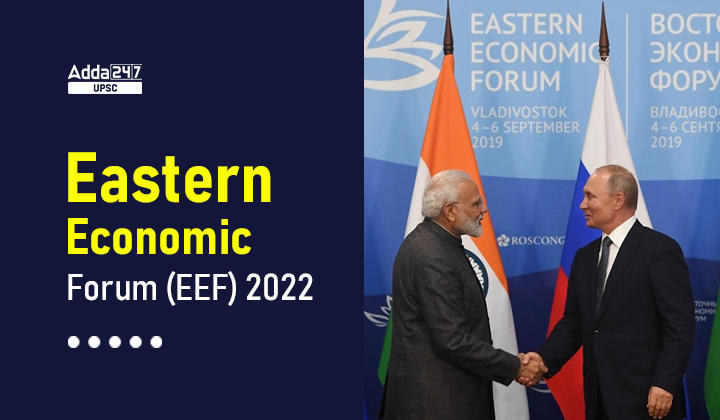Table of Contents
Eastern Economic Forum (EEF) 2022- Relevance for UPSC Exam
- GS Paper 2: International Relations- Bilateral, regional and global groupings and agreements involving India and/or affecting India’s interests.
Eastern Economic Forum (EEF) 2022 in News
- Recently, Prime Minister Narendra Modi virtually addressed Russia’s Eastern Economic Forum 2022 held in Vladivostok.
Eastern Economic Forum (EEF)?
- About: The EEF was established in 2015 to encourage foreign investments in the RFE. The EEF displays the economic potential, suitable business conditions and investment opportunities in the region.
- Mandate: The Eastern Economic Forum is an international platform aiming to foster communication and cooperation between members of the business community, political figures, experts, and journalists from Russia and the Asia-Pacific region.
- Key Objective: The primary objective of the EEF is to increase the Foreign Direct Investments in the Russia’s Far East Region.
- The region encompasses one-third of Russia’s territory and is rich with natural resources such as fish, oil, natural gas, wood, diamonds and other minerals.
- Focus Area: This year, the Eastern Economic Forum (EEF) 2022 aimed at connecting the Far East with the Asia Pacific region.
- Performance: Agreements signed at the EEF increased from 217 in 2017 to 380 agreements in 2021, worth 3.6 trillion roubles.
- As of 2022, almost 2,729 investment projects are being planned in the Russia’s Far East (RFE) region.
- The agreements focus on infrastructure, transportation projects, mineral excavations, construction, industry and agriculture.
What is Russia’s Far East Region?
- The Russian Far East is a region in Northeast Asia.
- It is the easternmost part of Russia, and is administered as part of the Far Eastern Federal District, which is located between Lake Baikal and the Pacific Ocean.
- It shares land borders with Mongolia, China, and North Korea to its south, as well as maritime boundaries with Japan to its southeast, and with the United States along the Bering Strait to its northeast.
China and Eastern Economic Forum (EEF)
- China is the biggest investor in the region as it sees potential in promoting the Chinese Belt and Road Initiative and the Polar Sea Route in the RFE.
- China’s investments in the region account for 90% of the total investments. Russia has been welcoming Chinese investments since 2015; more now than ever due to the economic pressures caused by the war in Ukraine.
- The Trans-Siberian Railway has further helped Russia and China in advancing trade ties.
- The countries share a 4000-kilometer-long border, which enables them to tap into each other’s resources with some infrastructural assistance.
- China is also looking to develop its Heilongjiang province which connects with the RFE.
- China and Russia have invested in a fund to develop northeastern China and the RFE, through collaborations on connecting the cities of Blagoveshchensk and Heihe via a 1,080 metre bridge, supplying natural gas, and a rail bridge connecting the cities of Nizhneleninskoye and Tongjiang.
South Korea and Eastern Economic Forum (EEF)
- Besides China, South Korea has also been gradually increasing its investments in the region.
- South Korea has invested in shipbuilding projects, manufacturing of electrical equipment, gas-liquefying plants, agricultural production and fisheries.
- In 2017, the Export-Import Bank of Korea and the Far East Development Fund announced their intention to inject $2 billion in the RFE in a span of three years.
Japan and Eastern Economic Forum (EEF)
- Japan is another key trading partner in the Far East. In 2017, Japanese investments through 21 projects amounted to $16 billion.
- Under Shinzo Abe’s leadership, Japan identified eight areas of economic cooperation and pushed private businesses to invest in the development of the RFE.
- Japan seeks to depend on Russian oil and gas resources after the 2011 meltdown in Fukushima which led the government to pull out of nuclear energy.
- Japan also sees a market for its agro-technologies which have the potential to flourish in the RFE, given similar climatic conditions.
- However, the momentum of trade that existed with Shinzo Abe was lost with the leadership of Yoshihide Suga and Fumio Kishida.
- The trade ties between Japan and Russia are hindered by the Kuril Islands dispute as they are claimed by both countries.
India and Eastern Economic Forum (EEF)
- India seeks to expand its influence in the RFE.
- During the forum, Prime Minister Narendra Modi expressed the country’s readiness in expanding trade, connectivity and investments in Russia.
- India is keen to deepen its cooperation in energy, pharmaceuticals, maritime connectivity, healthcare, tourism, the diamond industry and the Arctic.
- In 2019, India also offered a $1 billion line of credit to develop infrastructure in the region.
- Through the EEF, India aims to establish a strong inter-state interaction with Russia.
- Business representatives of Gujarat and the Republic of Sakha have launched agreements in the diamond and pharmaceuticals industry.



 TSPSC Group 1 Question Paper 2024, Downl...
TSPSC Group 1 Question Paper 2024, Downl...
 TSPSC Group 1 Answer key 2024 Out, Downl...
TSPSC Group 1 Answer key 2024 Out, Downl...
 UPSC Prelims 2024 Question Paper, Downlo...
UPSC Prelims 2024 Question Paper, Downlo...
